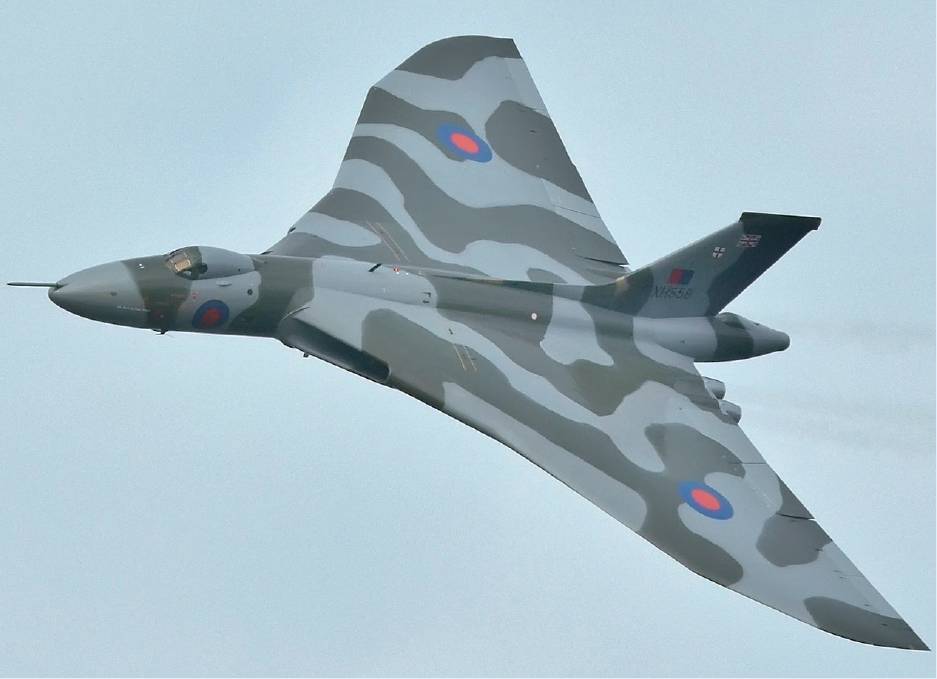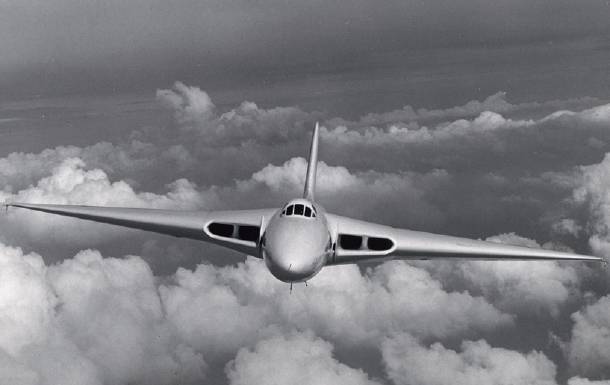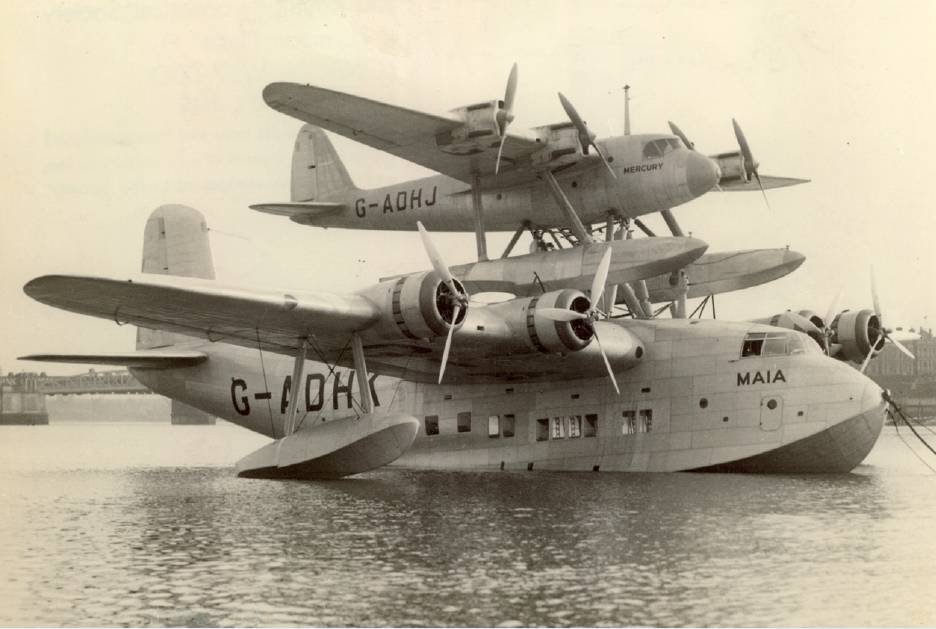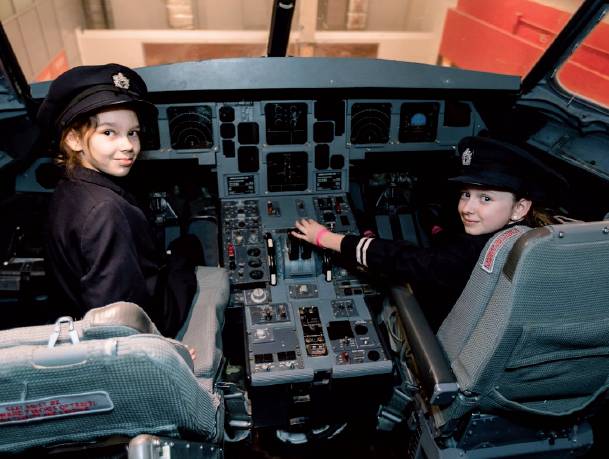Book Reviews
Book Reviews
Revised edition
By Tim McLelland
Crécy Publishing, 1a Ringway Trading Estate, Shawdowmoss Road, Manchester M22 5LH, UK. 2019. 304pp. Illustrated. £27.95. ISBN 978-1-91080-927-3.
 Avro Vulcan XH558 during its last flight over Farnborough on 11 October 2015. Alastair Barbour.
Avro Vulcan XH558 during its last flight over Farnborough on 11 October 2015. Alastair Barbour.
Tim McLelland is acknowledged to have written one of the most authoritative histories of the Avro Vulcan, first as The Vulcan Story (Arms and Armour Press.1993 and revised in 2002) under his pen name of Tim Laming – and also as The Avro Vulcan: A Complete History (Crécy Publishing. 2007) and later Vulcan – God of Fire (The History Press. 2012). The latest version The Avro Vulcan – Revised Edition – published in 2019 – is a further valuable revision, undertaken by Martin Derry, following Tim’s untimely death at the relatively young age of 53 in November 2015.
What is immediately striking about this new edition is the inclusion of so very many more colour photographs. The text is largely unchanged. However, the larger format has permitted an increased font size, making it an even more attractive read. The structure of the book has been expanded slightly: the first chapter covers the inception of the atomic bomb – including a somewhat historical version of the physics behind fission. I noted the mention of the famous PeierlsFrisch memorandum; I must be one of the few people left alive who met Professor Sir Rudolf Peierls, while I was a graduate at the Department of Nuclear Physics at Oxford.
 The first prototype Avro Vulcan, VX770. RAeS (NAL).
The first prototype Avro Vulcan, VX770. RAeS (NAL).
The second chapter explains how the Avro Vulcan with its famous delta planform came into being. Given the innovative nature of the design, three scaled versions were ordered prior to the construction of two full-sized prototypes – these are the subject of Chapter 3.
Apart from a short introduction, Chapter 4 is made up of Peter River’s recollections as an Avro employee of the design and development of the Vulcan. The fifth chapter covers the Vulcan’s introduction into RAF service, with the sixth describing the development of British nuclear bombs and how the Vulcan discharged its role as the main UK contribution to the NATO strategic nuclear deterrent from 1957 to 1969, after which the Royal Navy’s Polaris fleet took over.
Chapter 7 covers the Vulcan’s adventures in the Far East, Australia and New Zealand, part of its service life which is not well known. The eighth chapter explains what the Vulcan was like to fly and display, from the aircrew’s perspective. The ninth chapter describes the only time that the Vulcan was used in anger, during the campaign to liberate the Falkland Islands in 1982, just prior to when the last Vulcan bomber squadrons were stood down. The last Vulcan tanker squadrons were disbanded in 1984, eventually leaving just one Vulcan, XH558, flying in the display role.
Sadly, the story of how XH558 was returned to flight contains many inaccuracies, ones that will be corrected once I have written the definitive history of that project! I am glad though, that Tim McLelland lived long enough to witness the Vulcan’s return to flight for a further eight years.
Tim McLelland is acknowledged to have written one of the most authoritative histories of the Avro Vulcan
A number of appendices detail the entire Vulcan production list, including key dates for each aircraft and photographs of most; the Vulcan squadrons and (new) associated units; the Vulcan Wings, Bases and Dispersal Airfields; the 18 Vulcan airframe losses, and the Aircrew Manual.
All-in-all, a comprehensive record of the life and times of a famous and much-loved aircraft type.
Dr Robert Pleming
FRAeS
Sadly, this review was submitted before the untimely death of Dr Pleming on 2 February. Our thoughts are with his family and friends.
SHORT BROTHERS
The Rochester Years
By Philip MacDougall
Fonthill Media Limited, Millview House, Toadsmoor Road, Stroud GL5 2TB, UK. 2019.192pp. Illustrated. £20. ISBN 978-1-78155-730-3.
 The Short-Mayo composite aircraft, S21 Maia, G-ADHK, and S20 Mercury, G-ADHJ, was an attempt to fly mail over long distances. RAeS (NAL).
The Short-Mayo composite aircraft, S21 Maia, G-ADHK, and S20 Mercury, G-ADHJ, was an attempt to fly mail over long distances. RAeS (NAL).
Philip MacDougall has written a lively contribution to the literature on Short Brothers which shows that following the expansion of seaplane work at Shorts’ factory at Eastchurch, Isle of Sheppey, in 1913 Oswald Short established a branch factory where the River Medway offered better facilities for the operation of seaplanes.
After the Armistice at the end of WW1 in 1918 the business at Rochester was held together by diversification, building and overhauling Felixstowe flying boats and DH9 landplanes. The narrative then shows that Oswald staked all that the future lay in metal construction and traces the evolution of metal aircraft at Rochester (referencing National Archives files) culminating in the Empire, Sunderland, G-Class and Shetland flying boats (the Stirling bomber was less successful because the Air Ministry impaired the design at the specification stage).
Material in the National Archives on the formation of Short & Harland Limited in Northern Ireland in 1936, on the Rochester company’s tribulations leading to nationalisation under the Defence Regulations in 1943 and the government’s decision in 1946 to transfer Rochester’s production lines to Belfast would have consolidated the closing chapters. Among other errors, the figure for the number of Stirlings built at Rochester has been inflated three-fold by the inclusion of production at the dispersed factories around Swindon (187 Rochester, 352 Swindon, 539 total).
The illustrations in Short Brothers: the Rochester Years are above the usual standard in books on Shorts and refreshing use is made of first-hand statements and press reports. However, the introductory chapters are unduly long and take up pages better employed for the Rochester years. Unfortunately, the book repeats the myths that Shorts were the world’s first aircraft manufacturers and held a licence for the Wright Model A. The French aircraft industry was already flourishing (including serial production manufacture of Voisins and preparation by contractors to CGNA for the serial manufacture of Wrights) when Oswald made the first entry in Shorts’ Order Book in January 1909.
The illustrations in Short Brothers: the Rochester Years are above the usual standard in books on Shorts and refreshing use is made of ÿrst-hand statements and press reports
The promised Appendix on Shorts’ design team is missing from the review copy but surely would have spelled C P T Lipscomb’s name correctly. Important events in the evolution of the business at Rochester not reported in Short Brothers: the Rochester Years include:
- in 1917 Rochester became Shorts’ sole aircraft design and manufacturing centre when the Admiralty evicted the company from Eastchurch.
- in May 1919 the Short family incorporated a private company Short Brothers (Rochester & Bedford) Limited (Company No. 155564) and bought the original partnership. The success of Short Brothers (Rochester & Bedford) Limited was such that, in 1935, the company converted to public status to be quoted on the Stock Exchange.
The corporate history given in Short Brothers: the Rochester Years requires revision. Short Brothers (Rochester & Bedford) Limited emerged from the transfer to Belfast with a new name – S. B. (Realisations) Limited – a new role as the government-owned holding company for the shares in the Northern Ireland company which, in 1947, was renamed Short Brothers & Harland Ltd and, after two cosmetic changes of name, emerged in 1984 as Short Brothers plc. Ownership was transferred from Westminster to the Northern Ireland Department of Commerce in 1978 and the company was wound up in October 1993 following sale of Short Brothers Plc to the Canadian company Bombardier. Although the Belfast business traded as Bombardier, it retained its Companies Act name and registration as Short Brothers Plc and it was under that historic name that returns were made to the Registrar of Companies throughout the Bombardier years.
Although not without error or omission, Short Brothers: the Rochester Years is an engaging account of the Short company’s genius in producing memorable aircraft from what, in 1945, a Ministry of Aircraft Production report called ‘one of the worst collections of aircraft buildings in the country’.
Gordon Bruce
Short Brothers 1959-1979
ENGAGING THE NEXT GENERATION OF AVIATION PROFESSIONALS
Edited by Suzanne K Kearns et al
Routledge, Taylor & Francis Group, 2 Park Square, Milton Park, Abingdon OX14 4RN, UK. 2020. xix; 302pp. £45 [20% discount available to RAeS members via www.crcpress.com using AKQ07 promotion code]. ISBN 978-0-367-25427-8. RAeS members can access an e-book edition of this title online via the National Aerospace Library’s e-book service at www.aerosociety.com/ebooks
 Astronaut Tim Peake captivates children at a Royal Aeronautical Society Cool Aeronautics event at Hamilton Place on 9 November 2017.
Astronaut Tim Peake captivates children at a Royal Aeronautical Society Cool Aeronautics event at Hamilton Place on 9 November 2017.
Engaging the Next Generation of Aviation Professionals is an edited volume that aims to bring together diverse views from both academia and industry. It has three main themes of attracting, educating and retaining the aviation professional with a section dedicated to each theme. Each section contains a mix of case studies, scholarly chapters and professional reflections, although the majority are academic works.
Section 1 is all about attracting young people into aviation and provides several insights to industry operations and outreach programmes implemented in different parts of the world. Attraction is the first step on the path to, what can be, a very rewarding career.
Section 2 concentrates on educating future professionals and highlights the difference between the modern-day student and the student of years gone by. Technology plays a big part in the learning process for today’s student and this is explored in Chapter 2.5 ‘Ensuring Success by Using the four A’s of Learning’ with a follow-on in Chapter 2.6 ‘Engaging Practices for Training the New Generation of Aircraft Maintenance Technicians’. The different learning processes adopted for those who grew up with, and those without, technology is explored with suggested methods to getting the best out of the Gen Z.
 British Airways engaging children at Inspiring girls at KidZania in 2019. British Airways/Stuart Bailey.
British Airways engaging children at Inspiring girls at KidZania in 2019. British Airways/Stuart Bailey.
The focus of Section 3 is on retaining professionals. How does an industry retain its talent when there is a gap between the education and the regulatory recognition, whether that be maintenance experience for the engineer, hours building for the pilot or any other stipulation in the myriad of, necessary, legislation? This section details the historical issue of trained personnel diverting into other careers, whether computing or automotive, due to the lack of opportunity to hone the aviation skills learned. It suggests that, should an individual be unsuccessful in their chosen path, then a route to another career in aviation should be mapped, thereby retaining the resource in the air transport world.
Overall, the book presents a welcome overview of a long-known multidiscipline and international issue
The most irritating aspect about reading through the book sequentially was that virtually every contributor seemed to refer immediately to the Boeing Pilot & Technician Outlook. If you were not aware of a shortage before opening the book, you certainly were by the time you had read it. In saying that, proposed solutions to the highlighted problem are perfectly valid.
Overall, the book presents a welcome overview of a long-known multi-discipline and international issue. Alas the ‘one size fits all’ solution still evades us. However, the book does provide information on a variety of methods that may be utilised to engage the young person, each with a certain degree of success.
I found it to be a good source of inspiration, to think outside the box, in terms of training delivery to provide safe and competent professionals for the future.
Robert Sutherland
CMgr FRAeS
 Avro Vulcan XH558 during its last flight over Farnborough on 11 October 2015. Alastair Barbour.
Avro Vulcan XH558 during its last flight over Farnborough on 11 October 2015. Alastair Barbour.  The first prototype Avro Vulcan, VX770. RAeS (NAL).
The first prototype Avro Vulcan, VX770. RAeS (NAL). The Short-Mayo composite aircraft, S21 Maia, G-ADHK, and S20 Mercury, G-ADHJ, was an attempt to fly mail over long distances. RAeS (NAL).
The Short-Mayo composite aircraft, S21 Maia, G-ADHK, and S20 Mercury, G-ADHJ, was an attempt to fly mail over long distances. RAeS (NAL).
